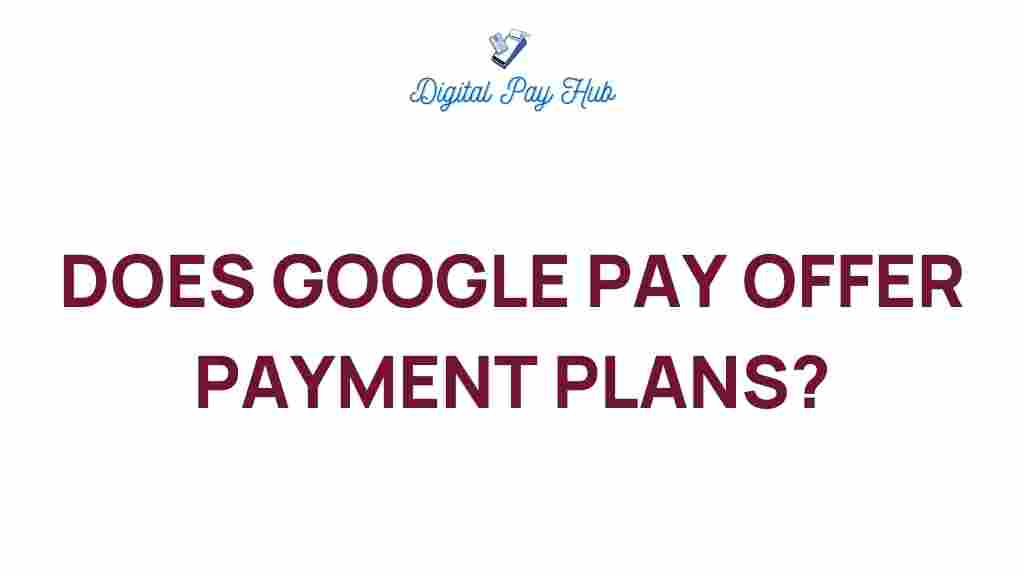Unraveling the Mystery: Does Google Pay Offer Payment Plans?
In recent years, the rise of mobile payments and digital wallets has revolutionized how consumers engage in transactions. Among the front-runners in this space is Google Pay, a platform that offers a seamless way to make purchases, send money, and manage finances. However, many users are left wondering: does Google Pay offer payment plans? This article will explore the options available within Google Pay, the benefits of using this platform for flexible payments, and how it fits into the broader landscape of financial technology. Let’s dive into the details!
Understanding Google Pay and Payment Plans
Google Pay is a digital wallet platform that allows users to make payments using their mobile devices. With its user-friendly interface and integration with various e-commerce platforms, Google Pay has become a preferred choice for many consumers looking to streamline their payment processes.
As consumers increasingly seek flexible payments that enhance their purchasing power, the question of whether Google Pay offers payment plans becomes crucial. Payment plans allow users to split their purchases into smaller, manageable installments, making it easier to afford larger items without financial strain.
Google Pay’s Current Offerings
As of now, Google Pay does not directly offer payment plans. However, it does integrate with third-party services that enable users to manage their payments more flexibly. Here are some options available to Google Pay users:
- Buy Now, Pay Later (BNPL) Services: Many e-commerce sites that accept Google Pay also partner with BNPL providers like Affirm, Afterpay, or Klarna. These services allow consumers to split their purchases into installments.
- Credit Card Options: Users can link their credit cards to Google Pay and utilize their card’s existing payment plan features, if available.
- Bank Partnerships: Some banks may offer installment plans for purchases made through Google Pay, depending on the user’s account type and creditworthiness.
For consumers looking for consumer options within Google Pay, it’s essential to explore these third-party features to benefit from payment flexibility.
How to Use Google Pay for Flexible Payments
While Google Pay itself may not offer direct payment plans, users can leverage the following steps to utilize flexible payment options through the platform:
Step 1: Set Up Google Pay
To start using Google Pay, download the app from the Google Play Store or Apple App Store. Follow these steps:
- Open the app and sign in with your Google account.
- Add your payment method (credit/debit card or bank account).
- Verify your payment method by following the prompts.
Step 2: Explore Merchant Payment Plans
When shopping online or in-store, check if the merchant accepts Google Pay and if they offer any financing options:
- Look for BNPL options at checkout, such as Affirm or Afterpay.
- Check if your credit card has a payment plan feature.
- Consult with your bank about any financing options linked to your account.
Step 3: Complete Your Purchase
Once you’ve selected a financing option, complete your transaction through Google Pay. Make sure to read the terms and conditions associated with any payment plan to understand the repayment schedule and interest rates.
Benefits of Using Google Pay for Transactions
Utilizing Google Pay for your transactions offers numerous advantages:
- Convenience: Google Pay allows for quick transactions, whether online or in-store, which is perfect for busy shoppers.
- Security: Google Pay employs advanced security measures, such as tokenization and biometric authentication, to protect user data.
- Integration: Google Pay works with various merchants and services, making it a versatile choice for consumers.
- Tracking Expenses: The app provides tools to track spending, helping users manage their finances more effectively.
Troubleshooting Common Issues with Google Pay
While Google Pay is designed to be user-friendly, you may encounter some issues. Here are some common problems and their solutions:
Issue 1: Payment Declined
If your payment is declined, check the following:
- Ensure your payment method is valid and has sufficient funds.
- Verify that the merchant accepts Google Pay.
- Check for any restrictions from your bank or credit card provider.
Issue 2: App Crashing or Freezing
If the Google Pay app is not functioning properly:
- Restart your device and try reopening the app.
- Ensure the app is updated to the latest version.
- Clear the app cache in your device settings.
Issue 3: Unable to Link Payment Method
If you cannot link your payment method:
- Check if your bank or card issuer supports Google Pay.
- Ensure that you have entered the correct information.
- Try linking a different payment method if possible.
Conclusion
In summary, while Google Pay does not directly offer payment plans, it provides users with access to various third-party services that facilitate flexible payments. As the landscape of mobile payments and digital wallets continues to evolve, Google Pay remains a strong contender in the financial technology sector, offering convenience and security for all types of transactions.
For consumers looking to enhance their purchasing options, exploring the integration of Google Pay with BNPL services and credit card payment plans can open up new avenues for managing expenses. By leveraging these options, users can take control of their finances and enjoy the benefits of a modern payment system.
For more information on how to make the most of your digital wallet, check out our comprehensive guide to mobile payments!
This article is in the category Payments and created by DigitalPayHub Team
